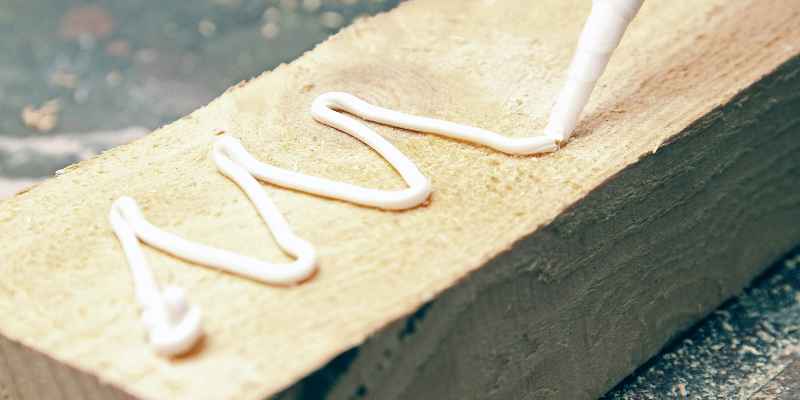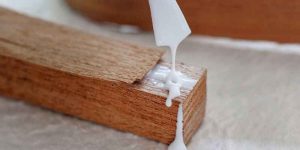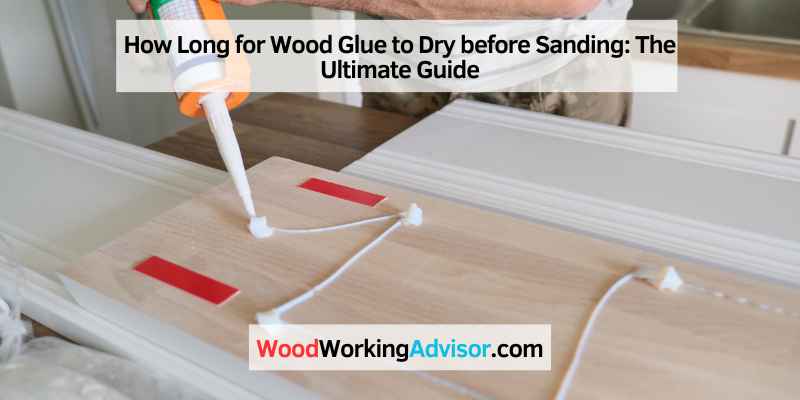Wood glue typically takes 24 hours to dry before it can be sanded. Woodworkers and carpenters who use wood glue will always face the question of how long to wait before sanding.
When sanding wood after gluing, many factors come into play, including humidity, temperature, and the type of glue used. Waiting the appropriate amount of time is essential to get the best results. Sanding too soon can ruin the project, while waiting too long can lead to unsightly glue marks.
We’ll explore the appropriate drying time for various types of wood glue and discuss some factors to consider before sanding your glued wood surface.
Types Of Wood Glue
The length of time required for wood glue to dry before sanding varies by glue type. Some glues, such as Titebond III, may take up to 24 hours to dry completely, while others may dry within a few hours. It is always best to reference the glue manufacturer’s instructions for specific drying times.
Pva Glue
If you are using PVA glue for your woodworking projects, then you will need to wait for at least 24 hours before sanding. However, if you are in a hurry and need to complete your project sooner, then you can start sanding the glued area after 4-5 hours. But keep in mind, that the glue may still be slightly wet, and sanding too early can cause the glue to smear and ruin the finish.
Polyurethane Glue
For polyurethane glue, you should wait for at least 6 hours before sanding the glued area. However, it is advisable to wait for 24 hours to get the best results. Polyurethane glue is known for its strength and durability, but it can be a bit more difficult to sand compared to PVA glue. It is recommended that you use a scraper to remove any excess glue and then sand the area lightly.
When it comes to woodworking, choosing the right type of glue is essential for a successful project. There are different types of wood glue available, and each has its unique properties and recommended drying time. The two most commonly used wood glues are PVA glue and Polyurethane glue.
PVA glue is the most widely used type of wood glue, and for a good reason. It is easy to work with, dries transparent, and is easily sanded after it has dried. Polyurethane glue, on the other hand, is best for projects that require a stronger bond. It forms an incredibly strong bond and is best suited for areas that are exposed to wet conditions.
If you’re wondering how long to wait before sanding the glued area, then the drying time for PVA glue is faster compared to polyurethane glue. In this article, we’ve discussed the recommended drying time for each type of glue. Ensure you let the glue dry completely before sanding to get the best results.
Factors Affecting Drying Time
The drying time for wood glue before sanding depends on several factors, including the type of glue used and the humidity and temperature in the working area. While some glues can dry in a few hours, others may require 24 hours or more before they are ready for sanding.
It is important to follow the manufacturer’s guidelines for drying time to ensure the best results.
When it comes to woodworking, wood glue is a crucial component in joining two pieces of wood together. However, it is important to give the glue enough time to dry before sanding the wood. There are various factors that affect the glue’s drying time, including humidity, temperature, type of wood, and type of glue used. Let’s take a closer look at each factor and its impact on the drying time.
Humidity
Humidity is the amount of moisture present in the air and it greatly affects the drying time of wood glue. If the air is humid and has high moisture, it takes longer for the glue to dry. In contrast, if the air is dry, the glue dries faster. If you are working in an area with high humidity, it is best to use a dehumidifier to remove excess moisture from the air.
Temperature
Temperature also plays a significant role in the drying time of wood glue. In general, the warmer the temperature, the faster the glue will dry. Conversely, if the temperature is too cold, the glue will take longer to dry. Ideally, the temperature should be between 18-24°C (65-75°F) for the glue to dry properly.
Type of Wood
Different types of wood have different levels of porosity, density, and moisture content, which can affect the drying time of wood glue. For instance, if you are working with dense hardwood like maple or cherry, it will take longer for the glue to dry as compared to softwood like pine or cedar. Moreover, if the wood has a high moisture content, it will also slow down the drying process.
Type of Glue
There are various types of wood glue available in the market, including PVA, polyurethane, and epoxy glue, each with different drying times. PVA glue is the most common type of wood glue, which dries quickly, while polyurethane glue takes longer to dry and creates a stronger bond. Epoxy glue is the strongest of all, but it also takes the longest to dry.
In conclusion, the drying time of wood glue before sanding depends on several factors, including humidity, temperature, type of wood, and type of glue used. Therefore, it is essential to consider these factors and plan accordingly. The right amount of drying time ensures a stronger bond and better sanding results.
How Long Does Pva Glue Take To Dry Before Sanding?

When using PVA glue on wood, it is recommended to let it dry for at least 24 hours before sanding. Squeezed-out glue can be cleaned with a damp cloth or mineral spirits. Some types of wood glue dry very hard and can be sanded after drying.
When it comes to working with wood, glue is an essential item that helps to keep all the pieces together. However, before you start sanding your glued work, it’s important to know how long it’s going to take for the glue to dry. For woodworking, PVA glue, also known as white glue or school glue, is the most popular type of glue used. In this blog post, we will focus on the subheading ‘How Long Does PVA Glue Take to Dry Before Sanding?’ and explore all aspects of the curing time of PVA glue.
Curing Time
The curing time of PVA glue varies depending on multiple factors such as the type and brand of the glue, the humidity and temperature of the environment, the amount of glue used, and the type of wood. However, as a general rule of thumb, PVA glue takes around 24 hours to dry completely before it’s ready for sanding. This drying time can vary depending on the thickness of the glue, the amount of humidity, and the temperature of the surrounding environment.
Ideal Conditions For Drying
The ideal conditions for drying PVA glue are dry, warm, and well-ventilated environments. When the humidity level of the environment is high, it can impact the curing time of the glue. Similarly, colder temperatures will slow down the drying process. Therefore, it’s essential to ensure that the temperature and humidity levels are optimal before starting the gluing process. Ideally, the temperature should be between 18°C to 24°C (65°F to 75°F), and the optimal humidity level should be around 50-60%.
Tips For Faster Drying
If you’re in a rush or working in a less-than-ideal environment, some tips can help speed up the drying process of PVA glue. One of the most effective ways to speed up the drying process is by using a clamp to squeeze the wood pieces together tightly. Not only will it help to achieve a strong bond, but it will also prevent the glue from spreading, resulting in a quick-drying time. Another tip is to use a space heater or fan to increase the ambient temperature around the work area. Finally, resist the temptation to sand the glue too soon; instead, wait the optimal 24 hours before starting the sanding process to ensure that the glue has completely cured.
In conclusion, when working with wood glue, it’s vital to understand how long it takes to dry before sanding. PVA glue, the most commonly used type of glue in woodworking, takes around 24 hours to dry completely. However, this curing time can be affected by multiple factors such as the environment’s temperature and humidity level. By following the tips mentioned in this blog post, you can speed up the drying process of PVA glue and achieve the perfect glue-up for your woodworking project.
How Long Does Polyurethane Glue Take To Dry Before Sanding?
The drying time of polyurethane glue before sanding depends on various factors like humidity, temperature and the type of wood being used. It is generally recommended to wait at least 24 hours before sanding, however, it is best to refer to the manufacturer’s instructions to ensure proper drying time.
Curing Time
Typically, polyurethane glue takes around 24 hours to cure properly. When working with polyurethane glue, it’s essential not to rush the drying process. If you sand the glued surface before it’s completely dry, you risk disrupting the adhesive bond and creating unsightly marks.
Ideal Conditions For Drying
Polyurethane glue dries best in environments that have a temperature range of 18-24°C and around 50-60% humidity. If the temperature is too low, the glue may take longer to dry, and if it’s too high, it may dry too quickly. Also, it’s ideal if you leave the glued item in a place with good airflow. Adequate ventilation ensures that the glue dries evenly, without any weak spots.
Tips For Faster Drying
If you’re working under a tight time frame, you can take some measures to speed up the drying process. Here are some tips to help you out:
- Keep the glue in a cool, dry place. This way, it’ll take less time to dry.
- Use a fan to increase airflow in the room. This will help the glue dry faster.
- Apply a thin layer of glue. This way, it’ll dry faster than a thick layer.
Overall, remember that patience is key when working with polyurethane glue. It’s best if you leave the glued item untouched for at least 24 hours before sanding it. Rushing the process will only lead to unsatisfactory results.
Can You Sand Wood Glue Before It Dries?
It’s important to let wood glue dry completely before sanding, as sanding too soon can ruin the project. The amount of time it takes for wood glue to dry before sanding varies depending on the type of glue used, but it’s generally recommended to wait at least 24 hours.
If you’ve ever worked with wood, then you know how indispensable wood glue is. Whether you’re building furniture or repairing old pieces, wood glue helps you ensure a strong and durable bond. But what should you do if you’re in a hurry and need to speed up the process? Can you sand wood glue before it dries?
Effects of Sanding Wet Glue
As tempting as it may be to sand wet wood glue, it’s important to remember that it’s not recommended. Sanding wet glue can have a few negative effects that can compromise the integrity of your project. First, sanding wet glue can smear it around, creating an uneven surface that’s difficult to work with. Second, the sanding process can push the glue farther into the pores of the wood, making it harder to remove completely. And finally, sanding wet glue can leave small scratches and marks on the surface that can be difficult to sand out once the glue has dried.
Alternative Solutions
If you need to speed up the drying process, there are a few alternative solutions you can try. First, make sure you’re using the right type of wood glue for your project. Some glues, like Titebond III, dry slower than others, so it’s important to choose the glue that’s best suited for your timeline. Second, try using a thinner layer of glue. Thicker layers of glue take longer to dry than thinner layers, so by using a thinner layer, you can accelerate the drying process. Finally, try applying a gentle amount of heat to the glue. This can help it dry faster without compromising the bond.
Conclusion
In conclusion, sanding wet wood glue is not recommended. It can compromise the integrity of your project and create a less-than-perfect finish. Instead, try using one of the alternative solutions mentioned above to speed up the drying process. With a little patience and careful application, you can achieve a strong and durable bond in no time.
How To Sand Wood Glue Properly
It is recommended to let wood glue dry for at least 24 hours before sanding it. The drying time can vary depending on the type of glue and humidity levels. Always check the manufacturer’s instructions for specific guidelines on drying time.
Once the wood glue has dried, it is crucial to sand it properly to achieve the desired smoothness and finish. However, sanding too early or with incorrect techniques can cause damage to the wood surface. In this section, we will look at the equipment needed to sand wood glue and the techniques to avoid damaging the wood.
Equipment Needed
To sand wood glue properly, you will need the following equipment:
1. Sandpaper – Choose the grit of sandpaper based on the roughness of the wood surface. Start with a lower grit and gradually move to higher grit sandpapers for a smoother finish.
2. Sanding block – Use a sanding block to keep the sandpaper even and avoid uneven spots.
3. Dust mask – Wear a dust mask to protect yourself from inhaling sawdust.
Techniques to Avoid Damaging the Wood
Now that you have the necessary equipment, follow these techniques to avoid damaging the wood while sanding:
1. Wait for the glue to dry completely – It is crucial to wait for the glue to dry completely before sanding to avoid damaging the wood. Most wood glues take 24 hours to dry completely.
2. Sand along the grain – Sanding along the grain will ensure a smooth finish and avoid creating scratches on the wood surface.
3. Use light pressure – Applying too much pressure while sanding can result in uneven spots or scratches on the wood surface.
4. Change the sandpaper often – Changing the sandpaper often will ensure that the sandpaper is not clogged with dust and can create an even finish.
In conclusion, sanding wood glue properly is crucial to achieving a smooth finish and avoiding damage to the wood surface. Make sure to use the proper equipment and techniques to achieve the best possible result.

Frequently Asked Questions On How Long For Wood Glue To Dry Before Sanding
How Long Should I Let Wood Glue Dry Before Sanding?
It is generally recommended to let wood glue dry for at least 24 hours before sanding. However, the drying time may depend on the type of glue and the conditions of the surrounding environment. It is advisable to follow the instructions provided by the glue manufacturer for the best results.
How Long Should I Leave Glued Wood Clamped?
It is recommended to leave glued wood clamped for at least 24 hours before sanding. However, this can vary based on factors such as temperature, humidity, type of glue used, and the size of the project. It is best to follow the instructions provided with the glue and allow for a longer drying time if necessary.
How Long Before You Can Sand Titebond 3?
It is advised to let Titebond 3 wood glue dry for at least 24 hours before sanding. Some glues dry very hard, so it’s essential to ensure it is completely dry before proceeding with sanding. Any excess squeezed out can be removed using a damp cloth, and mineral spirits can be used to clean any residual glue.
Can You Sand Titebond Wood Glue?
Yes, you can sand Titebond wood glue. However, some of these glues dry very hard, especially the Ultimate III variant. If there is any squeeze-out, you can wipe it off using a damp cloth. Also, you might need mineral spirits to clean up any residual glue, especially for the Polyurethane variant.
Conclusion
To conclude, the time wood glue takes to dry before sanding can vary depending on the type and brand of glue used. However, a general rule of thumb is to wait for at least 24 hours before sanding. Waiting longer may result in a stronger bond and a smoother finish.
It’s always important to follow the manufacturer’s instructions and ensure the glue is fully cured before applying any pressure or stress to the joint. With proper drying time, wood glue can provide a durable and long-lasting bond for all your woodworking projects.


